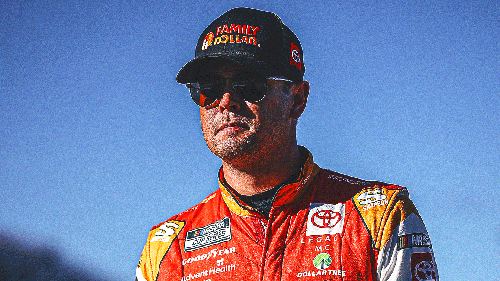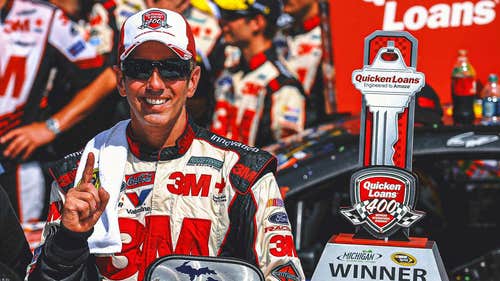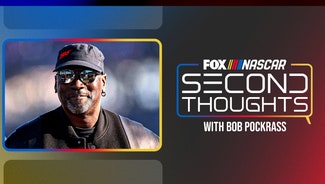
NASCAR teams facing Next Gen car shortage before Daytona
By Bob Pockrass
FOX Sports NASCAR Writer
DAYTONA BEACH, Fla. – The concern is real. Wreck a couple of race cars early in the 2022 season, and a driver or team might have to scramble to have a car ready for a race as the NASCAR Cup Series transitions to the Next Gen car.
What’s also real? Most drivers get paid not to care about that.
When there is a trophy, a big check and a playoff spot on the line, drivers typically don’t hesitate to push a car to its limits.
But as the 2022 season quickly approaches, teams are getting nervous. The Busch Clash is a little more than three weeks away (Feb. 6 at the Los Angeles Memorial Coliseum), and Daytona 500 practice begins in less than five weeks (Feb. 15).
NASCAR originally believed that teams would have five cars (for each car number they field) completed by the start of the season, but teams at the Daytona test Tuesday and Wednesday indicated that they had just two completed cars, with a third being assembled. Team owners seemed to believe that they won't have five completed cars until closer to the end of February.
What happened? As teams discovered handling and heat issues in testing last fall and after NASCAR conducted additional safety tests, NASCAR tweaked several parts and pieces. That delayed the delivery of main components to teams.
Supply issues for vendors — teams must purchase all major parts and pieces (except the engine) from approved vendors, unlike with previous cars that teams manufactured — have also slowed completion. It can take an organization a couple of weeks or more to assemble a car.
NASCAR Vice President John Probst said Tuesday that NASCAR still believes every team will have five center chassis and seven front and rear clips by the week of the Daytona 500. How many cars will be fully assembled, though, appears uncertain.
"We’re not immune to the world," Probst said. "We’re seeing with COVID and supply chains being delayed some of the distribution being delayed a little bit.
"Right now, we don’t see any parts or pieces that are going to keep any car from racing in an event. ... Time will tell. But right now, we’re concerned, but we’re not in a situation where folks are not going to be able to race."
The biggest concern is that between practice, qualifying races and the Daytona 500, several cars typically end up with significant damage after the opening week of the year. Then teams embark for three races on the west coast in Fontana (California), Las Vegas and Phoenix.
Penske driver Joey Logano said the car he tested at Daytona will be used for the preseason exhibition Clash as well as the race in Fontana.
"That’s the position we’re all in," Logano said. "It’s tight. Don’t crash."
That is way easier said than done.
"That’s why I was surprised at how hard we were racing [at the test Tuesday]," Logano said. "I was like, if we wreck these things, we’re in a bit of trouble.
"You put a bunch of drivers out there trying to learn something and start racing each other, it ended up being a race."
Denny Hamlin's crew chief, Chris Gabehart, said that with a month until Daytona, drivers could afford to mix it up a little in the test — a luxury they won’t have during the Feb. 15-20 race week, which includes practice Tuesday, single-lap qualifying Wednesday, qualifying races Thursday, practice Friday and Saturday, and the Daytona 500 on Sunday.
"I would venture to say you saw some of the more exciting drafting today than what you will see [in] Speedweeks practice [because] you will have very little time to recover [next month]," Gabehart said.
"That will be in the back of everybody’s mind, but that is part of the strategy. We’re all in the same boat."
With Hamlin blowing an engine on the first day of the test, Joe Gibbs Racing didn't even test on the second day. The organization brought only one car, even though it could have two at the test, in order to keep people at the shop working on cars and also limit the chances of damaging a car.
Stewart-Haas Racing skipped the test entirely, as did a couple of other teams. Those who attended (there were 17 cars) breathed a sigh of relief after they didn’t incur any damage.
"It’s on my mind because it’s hard to know what is going to happen in the next four weeks," said Trackhouse Racing owner Justin Marks, whose team expanded from one to two cars this year after the purchase of Chip Ganassi Racing.
"We’re prepared to do the work. It’s just what is going to show up at the back door [as far as parts and pieces]."
The Next Gen car is designed to be fixed quickly if there is a crash. In fact, Austin Dillon had a hard crash at Charlotte testing last month, and the team repaired the car and had it back on track in about eight hours.
"We have two right now per [driver]," Dillon team owner Richard Childress said. "The season starts pretty soon. You’ve always got some concerns.
"NASCAR is approaching it right from a safety standpoint because we went back after each crash test, and they would go back and make changes to make the cars safer and better.
"That’s one of the reasons we got behind. ... We have got some cages and front and rear clips. The shortages are on pieces. We’ll be OK — I think."
Hearing him talk would seem unlikely to comfort a driver.
"The Daytona 500 is the biggest race of the year for us, so we won’t be tentative, for sure, for that one," former Daytona 500 winner Dillon said. "We’ll let it out there for the 500. But if you get behind early, it could be trouble after a couple of weeks."
The trouble might not be having a car to race. But the impact on the organization as a whole at the start of what is a grind of a season could be concerning.
"Outside of having another COVID lockdown or some significant accidents, I think we’ll have enough cars to race," driver and co-owner Brad Keselowski said. "I’m not too concerned about that.
"But I am concerned about the emotional and physical well-being of some of the people that work on the race cars."
As a driver and co-owner, Keselowski said he will try not to think about the ownership side as he races.
"Most of the drivers, it won’t be in the back of their head — maybe that’s good, maybe that’s bad," he said. "When it’s time to race, you’ve got to race. You can’t be worried about tearing up cars and things like that."
Ricky Stenhouse Jr. — who drives for a one-car organization, meaning the organization is among those with the fewest cars in its fleet — said he was told not to worry about it. So he won’t.
But that doesn’t mean it's not on his mind.
"I was pretty white-knuckled the other day in that 10-lap drafting session," Stenhouse said during the test. "You just don’t want to make a mistake, just because they are all brand-new cars, and we’re just trying to learn them all.
"As we kind of get accustomed to the car and throughout the season — I think for the Daytona 500, everybody is still going to be on edge, at least until the end of the race, because you’re going to learn a lot in those 500 miles and get more comfortable. But we’re still a little bit on edge with the car, for sure."
In the Daytona 500, some drivers have for several years opted to hang behind the main pack, hoping to avoid the usual carnage and find themselves with a chance at the end.
"We were on ultraconservative mode last year because it pays so damn much," Spire Motorsports driver Corey LaJoie said. "It’s almost worth riding for 495 miles, and when the pay window opens up, hopefully you get a top-10.
"That was our goal last year, and that’s probably what it will be this year, especially knowing you can’t afford to completely trash a car."
Probst said NASCAR is working with its vendors, and if they need additional personnel, NASCAR will use its connections with teams to find those who need the work. NASCAR is also helping find suppliers of materials if a vendor can’t locate them.
The teams? They are kind of at the mercy of NASCAR and the vendors because the rules prohibit them from developing parts and pieces for this new car — a way for NASCAR to eventually control costs, as well as potentially increase parity.
Teams will be limited to seven cars in rotation at any given time. They cannot replace a car until it runs in at least three races. If a car is crashed, NASCAR and the chassis supplier (Technique) will determine if the chassis can be repaired or needs to be replaced.
"We’re in the same boat as everybody else, so we’re still competing, whether we’re competing with two cars, four cars or seven cars," Gabehart said.
"What our industry does better than any other — we proved a year-and-a-half ago [with pandemic protocols] — is adapt to circumstance. A year-and-a-half ago, we all figured out how to adapt to circumstance. This will be no different. We’ll be fine."
That will be the competitor's attitude.
"I think everyone has got a plan until they get punched in the mouth," Marks said. "Everybody is going to take the green flag at the Daytona 500 and go racing. We’ll see. A lot is going to happen over the next month."
Looking for more NASCAR content? Sign up for the FOX Sports NASCAR Newsletter with Bob Pockrass!
Thinking out loud
One move drivers attempted at the Next Gen test was a tandem draft, in which one driver uses the front bumper to push the other driver’s rear bumper. The cool conditions kept engines from overheating. And while the bumpers are curved and there is potential for wrecks, with two or three laps to go in the Daytona 500, every driver would take that risk for extra tenths of a second on the field.
NASCAR fans, in general, hate that style of racing because the driver doing the push has little chance of overtaking the other driver (the incentive is to get ahead of the rest of the pack). Should NASCAR make a no-tandem-drafting rule for Cup, like it has in place for Xfinity and trucks?
No. NASCAR has enough judgment calls as it is, and adding that rule would be asking for controversy because with millions of dollars on the line, a driver would be stupid not to still try it. After all, daring NASCAR to make a call is the way boundaries are defined in this sport.
The Daytona 500 shouldn't be decided on whether someone pushed for "too long." And neither should the playoff cutoff race at Daytona in August. Cup drivers should be talented enough to not crash.
If NASCAR doesn’t want tandem racing, it needs to figure out something with the engine cooling system at these tracks so that drivers can’t do it for even half a lap or else the engine would blow.
Next Up: Next Gen
The next test for the Next Gen car will be Jan. 25-26 in Phoenix. It should be the least dramatic of the tests, as many of the issues as far as the cars and the aerodynamic package have been dissected and finalized.
Why go all the way to test on the one-mile Phoenix track? Because that is where the championship race is, and gathering data on this car and this track will help teams make plans not just for the Phoenix race in March but also for the title-deciding season finale.
Social spotlight
They said it
"There are a few races in the world that stand out. You have the Indy 500, the 24 Hours of Le Mans and then Daytona. It’s part of that very small group of special races and tracks to drive at. ... It would be extremely special [to do the 500]." — former F1 champ and Indy 500 winner Jacques Villeneuve, who plans to attempt to qualify for the Daytona 500
Bob Pockrass has spent decades covering motorsports, including the past 30 Daytona 500s. He joined FOX Sports in 2019 following stints at ESPN, Sporting News, NASCAR Scene magazine and The (Daytona Beach) News-Journal. Follow him on Twitter and Instagram @bobpockrass. Looking for more NASCAR content? Sign up for the FOX Sports NASCAR Newsletter with Bob Pockrass!









































































































































